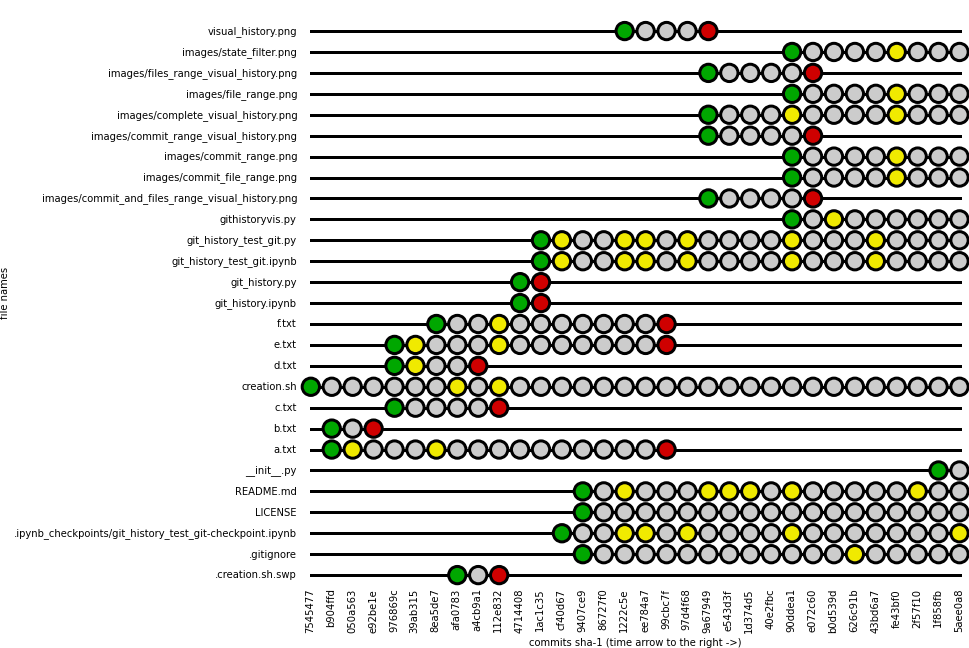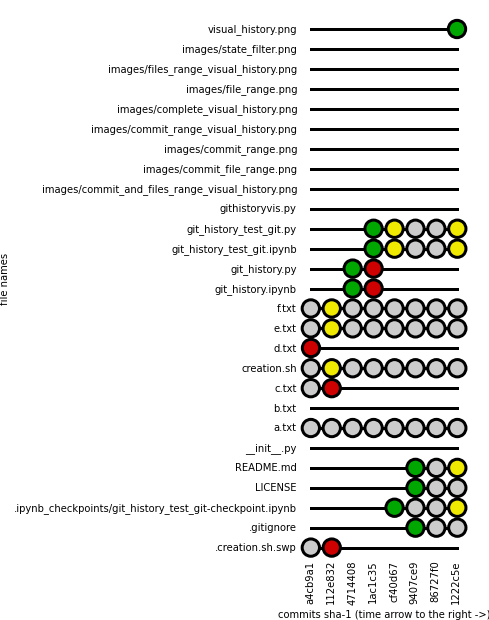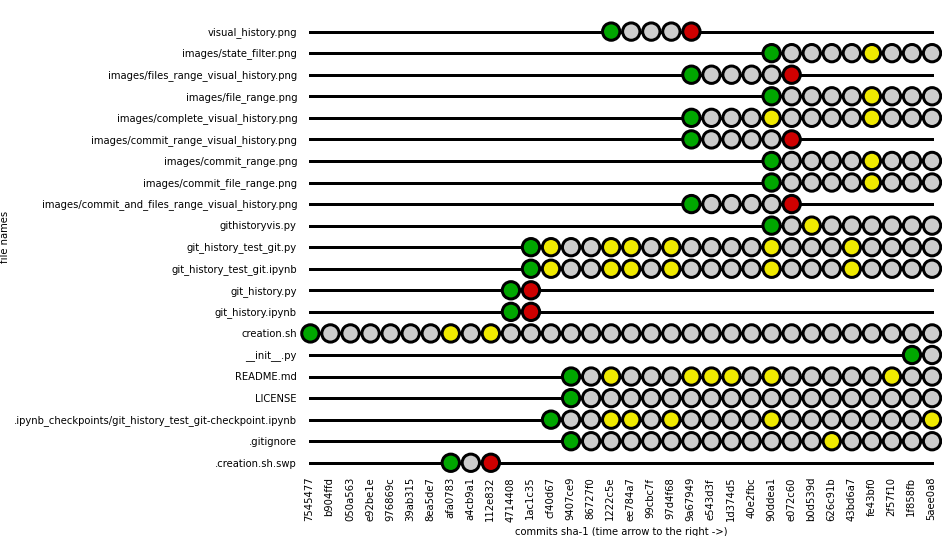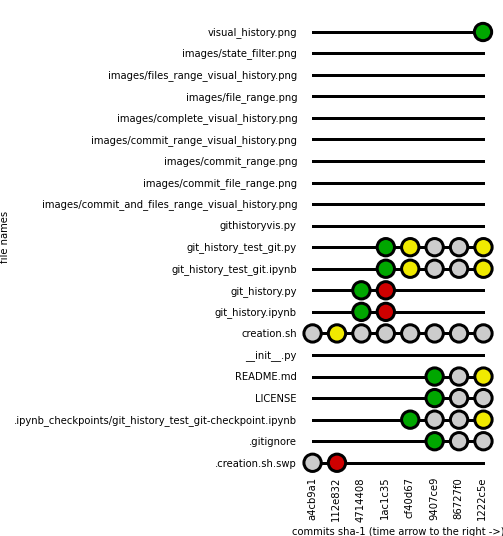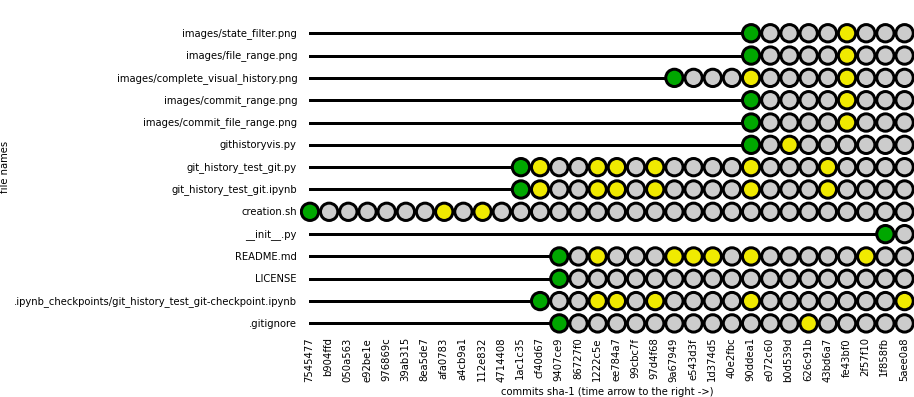This script solve this problem:
I want to visualize the history of all the files in a git repository [in one branch]
The idea is to extract the whole commits log via the git command (you should have it on your machine) and process it to have:
- the list off the file ever existed in this branch
- the list of allsthe commit (at this stage we use the short SHA-1)
- Pandas (for data handling)
- Matplotlib (for image generation)
git_history is the common base class for all git history.
foo = git_history(PATH, get_history=False, definedatamatrix=False)
Optionally, set get_history and definedatamatrix to True to have all the process done in place, instead of calling each method.
At the inizialitation the attribute self.path that point to the git respository in PATH.
Also def_states (and def_states_explain) are defined at inizialitation. They are used to transform the state in the dataframe to number for visualization and define the legend. You can overwrite them at your own risk.
# that is used as colorcode in the datamatrix
def_states = {
u'A': 120,
u'C': 25,
u'B': 51,
u'D': 240,
u'M': 180,
u'R': 102,
u'U': 204,
u'T': 76,
u'X': 153,
u'S': 255, # custom value, Static
u'N': None, # custom value, Non existent
}
# this is only a humand readable format
def_states_explain = {
u'A': u'added',
u'C': u'copied',
u'D': u'deleted',
u'M': u'modified',
u'R': u'renamed',
u'T': u'type changed',
u'U': u'unmerged',
u'X': u'unknown',
u'B': u'pairing broken',
u'S': u'Static',
u'N': u'Non existent'
}
The method
foo.get_history([prettyformat='%h'],[gitcommitlist=False])
extract the git log, and define:
- foo.all_commits = the whole git log
- foo.commits = the commits SHA-1
- foo.all_files = all the unique file ever existed
arguments:
prettyformat, default %h
optional, accept one of the git prettyformat, see http://git-scm.com/docs/pretty-formats. For example, get the whole commit text with '%s' and write your own parser for sel.decodelog().
Deafault is '%h' of the short SHA-1 of the commit.
gitcommitlist, default False
optional, if present should be a string withthe result of:
git -C PATH --no-pager log --reverse --name-status --oneline --pretty="format:COMMIT%x09%h"
For example, execute this command in remote and store the result in a file, read the content
with open('gitoutput', 'r') as file:
data = file.read()
and pass the result to get_history method:
gt.get_history(gitcommitlist=data)
From the official git-log Documentation, http://git-scm.com/docs/git-log for files status:
- A : file Added
- D : file Deleted
- M : file Modified
- C : Copied
- R : Renamed
- T : Type changed
- U : Unmerged
- X : unknown
- B : pairing Broken
Custom defined status:
- S : file is Static (nothing happen)
- N : file is Non existent
See http://git-scm.com/docs/git-log :
...
--diff-filter=[(A|C|D|M|R|T|U|X|B)…[*]]
Select only files that are Added (A), Copied (C), Deleted (D), Modified (M), Renamed (R), have their type (i.e. regular file, symlink, submodule, …) changed (T), are Unmerged (U), are Unknown (X), or have had their pairing Broken (B). Any combination of the filter characters (including none) can be used. When * (All-or-none) is added to the combination, all paths are selected if there is any file that matches other criteria in the comparison; if there is no file that matches other criteria, nothing is selected. ...
The simplest way to get your image is to open example_githistoryvis.py, change the repository pathm the output path , save and run python example_githistoryvis.py.
To have a better look of what is happening, the notebook and the python script included (git_history_test_git.ipynb and git_history_test_git.py) are extended examples.
Change the path at the beginning with your repository path and play with the visualizzation at the end.
This example is on this very repository. The first *txt files were only placeholders.
This is the complete visual history of this repository using
plot_history_df(gt.datamatrix,size= 300, figsize = [10,14])This is a commit range, using using pandas' Indexing and Selecting Data capabilities:
plot_df_commit_range = gt.datamatrix.ix[:,'a4cb9a1':'1222c5e']
plot_history_df(plot_df_commit_range,size= 300, figsize= [3,13])This is a range of files, using
plot_df_file_range = gt.datamatrix[~gt.datamatrix.index.str.contains('txt$')]
plot_history_df(plot_df_file_range,size= 300, figsize= [10,11.5])This is combines the two filters, using
plot_df_commit_file_range = all_filenames.ix[:,'a4cb9a1':'1222c5e']
[~all_filenames.index.str.contains('txt$')]This is filter on the all the state in the last commit, using
plot_df_state_filter = gt.datamatrix[gt.datamatrix[gt.datamatrix.columns[-1]] != 'N']
plot_history_df(plot_df_state_filter,size= 300,figsize= [10,10])